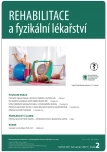The effect of manipulation therapy on cervicocranial syndrome
Authors:
P. Konečný 1 3; Musálková M. 1; Papajová L. 1; Elfmark M. 1,4; Vyskotová J. 1; Můčková A. 1; Aláčová Gaul P. 1; Vysoký R. 1; Krejstová G. 2
Authors‘ workplace:
Ústav klinické rehabilitace, Fakulta zdravotnických věd, Univerzita Palackého v Olomouci
1; Neurologická klinika, Lékařská fakulta, Univerzita Palackého v Olomouci
2; Katedra fyzioterapie a rehabilitace, Lékařská fakulta, Masarykova univerzita, Brno
3; Katedra přírodních věd v kinantropologii, Fakulta tělesné kultury, Univerzita Palackého v Olomouci
4
Published in:
Rehabil. fyz. Lék., 28, 2021, No. 2, pp. 75-78.
Category:
Original Papers
doi:
https://doi.org/10.48095/ccrhfl202175
Overview
The symptoms of cervicocranial syndrome include headache caused by cervical spine disorder. The treatment of cervicocranial syndrome requires a comprehensive multidisciplinary approach using pharmacological treatment and non-drug procedures, including physiotherapy and myoskeletal therapy. There is a consensus that the physiotherapy procedures of mobilization and manipulation are beneficial in the treatment of cervical spine disorders. The aim of the study was to evaluate the effects of manipulation therapy of the cervical spine according to the principles of myoskeletal medicine. The study included 103 patients with cervicocranial syndrome, who were randomly divided into a control and an experimental group. The control group underwent standard physiotherapy myoskeletal treatment. In addition to the standard physiotherapy myoskeletal treatment, the experimental group received one initial thrust manipulation of the cervical spine at the very beginning of the treatment. The results of our study showed that the manipulation of the cervical spine led to a significant increase in immediate mobility after the therapy. An improvement of cervical spine mobility and pain reduction were observed in both groups after six weeks of comprehensive physiotherapy myoskeletal treatment. The differences between the experimental group and controls were shown to be non-significant.
Keywords:
cervicogenic headache syndrome – Pain – cervical spine rotation – myoskeletal medicine – spine manipulation
Sources
1. Lewit K. Manipulační léčba v myoskeletální medicíně. Praha: Sdělovací technika ve spolupráci s Českou lékařskou společností JEP 2003.
2. Rychlíková E. Manuální medicína. 2. přeprac. vyd. Praha: Maxdorf 1997.
3. Haldeman S, Dagenais S. Cervicogenic headaches: a critical review. Spine J 2001; 1(1): 31–46. doi: 10.1016/s1529-9430(01)00024-9.
4. Martelletti P, van Suijlekom H. Cervicogenic headache: practical approaches to therapy. CNS Drugs 2004; 18(12): 793–805. doi: 10.2165/00023210-200418120-00004.
5. Avijgan M, Thomas LC, Osmotherly PG et al. A systematic review of the diagnostic criteria used to select participants in randomised controlled trials of interventions used to treat cervicogenic headache. Headache 2020; 60(1): 15–27. doi: 10.1111/head.13719.
6. Vacek J. Současný pohled na manipulaci krční páteře. Sanquis 2010; 74 : 93–95.
7. Dunning JR, Butts R, Mourad F et al. Upper cervical and upper thoracic manipulation versus mobilization and exercise in patients with cervicogenic headache: a multi-center randomized clinical trial. BMC Musculoskelet Disorder 2016; 17 : 1–12. doi: 10.1186/s12891-016-0912-3.
8. Cooper WM, Masih AK. Cervicogenic headache. In: Diamond S, Cady R, Diamond M et al. (eds). Headache and migraine biology and management. Academic Press 2015; 203–212.
9. Janda V, Lewit K. Bolesti hlavy myoskeletální etiologie. Doporučené postupy pro praktické lékaře ČLS JEP 2001; 1–5.
10. Grant T, Niere K. Techniques used by manipulative physiotherapists in the management of headaches. Austr J Physiother 2000; 46(3): 215–222. doi: 10.1016/s0004-9514(14)60330-5.
11. Whittaker R. The effectiveness of an electromechanical adjusting instrumental compared to cervical spine manipulation in the treatment of cervicogenic headaches. Durban University of Technology, South Africa 2018. [online]. Available from: https://openscholar.dut.ac.za/handle/10321/3081.
12. Ylinen J, Nikander R, Nykänen M et al. Effect of neck exercises on cervicogenic headache: a randomized controlled trial. J Rehabil Med 2010; 42(4): 344–349. doi: 10.2340/16501977-0527.
Labels
Physiotherapist, university degree Rehabilitation Sports medicineArticle was published in
Rehabilitation & Physical Medicine

2021 Issue 2
Most read in this issue
- The effect of manipulation therapy on cervicocranial syndrome
- Historical development of motor control theories – from hierarchical theory to dynamic system
- Influence of footbike riding on the locomotor system of younger school children
- Effectiveness of therapeutic interventions in the treatment of pain associated with trigger points
